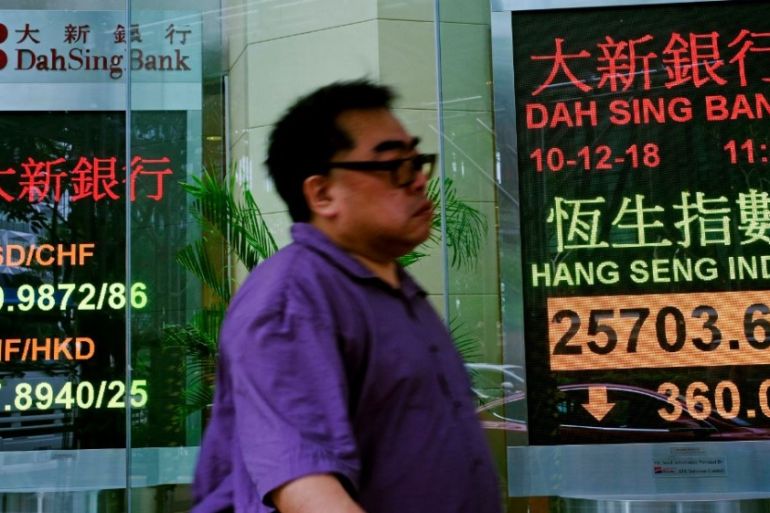Asian shares struggle to bounce back as coronavirus worries surge
A sharp increase in infections globally sparks fresh concerns that the coronavirus could do more economic damage.

Asian share markets were trying to stabilise on Tuesday after a wave of early selling petered out and Wall Street futures managed a solid bounce, allowing investors to take a break from coronavirus fears.
Some dealers cited a Wall Street Journal report on a possible vaccine as helping sentiment, though human tests of the drug might not start until the end of April.
Keep reading
list of 3 itemsSea of Red: US stocks hammered on coronavirus fears
Buffet warns investors ‘Don’t get caught up in virus headlines’
Whatever the cause, E-Mini futures for the S&P 500 recovered 1 percent to pare some of the steep 3.35 percent loss the cash index suffered overnight.
In South Korea, where coronavirus cases have surged, the hard-hit Kospi edged up 0.8 percent and helped MSCI’s broadest index of Asia-Pacific shares outside Japan fight back to flat.
Japan’s Nikkei was still down 2.8 percent, but just catching up to the global sell-off having been shut on Monday. Shanghai blue chips eased 0.7 percent but had also bounced back from early lows.
Shares in the United States and Europe had suffered their biggest loses since mid-2016 amid fears the coronavirus was morphing into a pandemic that could cripple global supply chains and wreak far greater economic damage than first thought.
The risks were such that bond markets were wagering central banks would have to ride to the rescue with new stimulus.
Futures for the US Federal Reserve funds rate have surged in the last few days to price in a 50-50 chance of a quarter-point rate cut as early as April. In all, they imply more than 50 basis points, or 0.5 percent, of interest rate reductions by year’s end.
Central banks across Asia have already been easing policy, while governments have promised large injections of fiscal stimulus, something Western countries might also have to consider.
“This is a world now where economies are so intertwined that it’s hard to know what the economic impact will be,” said Rodrigo Catril, a currency strategist at NAB.
“It’s certainly hard to see a catalyst that might stop the losses in the near term, though the market has moved aggressively to price in US rate cuts as early as June.”
Underlining the economic effects of the virus was a 3.5 percent drop in Apple Inc as data showed sales of smartphones in China tumbled by more than a third in January.
The Dow ended Monday down 3.55 percent, while the S&P 500 lost 3.35 percent and the Nasdaq 3.71 percent. Wall Street’s fear gauge, the CBOE Volatility Index, jumped to its highest close since early 2019.
Bond yields near all-time low
The coronavirus death toll climbed to seven in Italy on Monday and several Middle East countries were dealing with their first infections, feeding worries it could turn into a pandemic.
“If travel restrictions and supply-chain disruptions spread, the impact on global growth could be more widespread and longer-lasting,” said Jonas Goltermann at Capital Economics.
“While we still think that it would take a significant deterioration in the outlook for the US economy for policymakers to cut rates, they may feel compelled to do so if the virus spreads and leads to continued falls in the stock market and inversion of the Treasury yield curve.”
The rush to bonds drove yields on 10-year Treasury notes down 10 basis points to 1.37 percent, so paying less than a three-month deposit. Yields are now rapidly approaching the all-time low of 1.321 percent hit in July 2016.
The sharp drop, combined with the simple fact the Fed had far more room to cut rates than its peers, kept the US dollar restrained after a run of strong gains.
The euro edged up a little from recent three-year lows to reach $1.0853, while the US dollar was back at 110.90 yen and away from a 10-month top of 112.21.
Against a basket of currencies, the US dollar was all but steady at 99.339.
The search for safe harbours saw gold touch a seven-year peak at $1,688.66 an ounce overnight. Profit-taking set in early Tuesday leaving the metal at $1,646.26.
Demand worries saw oil prices go the other way to shed nearly 4 percent on Monday. US crude was up 5 cents at $51.48 on Tuesday, while Brent crude was yet to trade.